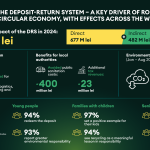
The brave new world of work
Foto: NEW_PHOTOS/ depositphotos.com
The still headline grabbing COVID-crisis is said to have an upside as well. Picture a young man or woman sitting on a comfortable chair at a beach bar, his or her relaxed gaze brushing on turquoise ocean waters, finally resting on serene green hilltops. A cold drink is placed right next to a laptop showing a pie-chart. Of course, slight variations of the idyllic view are also possible, with coffees instead of drinks, tablets instead of laptops and other graphs.
No matter the details, the message conveyed is extremely strong – this is the future of work. No wonder pictures like this adorn the title page of presentations by HR departments in many companies. Even some states firmly believe in this future and want to capitalize on it. Countries in the Caribbean region, but also in Europe (like Germany, Iceland, the Czech Republic and others) actively try to attract such digital nomads by introducing special visas.
Suddenly, everybody seems to crave jobs that offer more freedom and meaning. In a survey of more than 2,000 people in the UK and Ireland, more than a third of respondents said they were looking to change roles in the near future or once the economy had strengthened. In the USA, a record 4 million people quit their jobs in April and the rate remains high. Experts even coined the term “Great Resignation” for this now.
In Romania, almost 50% of people asked about their plans by the HR platform Best Jobs said they think about becoming freelancers because they want more flexibility of work hours, independence, freedom of working from everywhere or potentially higher earnings.
What happened? Put simply, a pandemic.
In Romania, where employers tend to notoriously micromanage and control more, the idea of remote working seemed absurd before the various lockdowns of 2020. Allowing people to work from outside their offices, without proper supervision? Forget about this nonsense. But the concept gained traction when managers noticed that productivity didn’t decrease when people worked from home, and in some cases they even saw a gain. I talked about this with Eugen Petala, who is the managing partner of a language service provider in Bucharest. During the lockdown, two of their translators were able to work exclusively from home and as far as he could tell, their productivity looked the same in terms of output. But his feeling is that they worked longer than 8 hours so the real hour productivity was – if his intuition would prove to be correct – somewhat lower than before. At his company, they only keep an eye on the output, so supervision was pretty much the same as before. After a point, the German language courses his company offers migrated online, Petala recalls. From the productivity of teachers’ point of view, there was no problem: you can test students online as well.
Romania is a country with almost no speedways and bad local transport quality. Commuting seems to take forever, but at the same time the country has one of the fastest internet connections available. Under these circumstances working from home seems like a good solution. Mainly people in the IT and creative business and even newer industries like coaching jumped on it. Something like a movement spawned almost overnight, inspired by the success stories of people abandoning the noisy, crowded cities for a place in the countryside, where the air is better and children can grow up in a healthier environment. Houses are bigger and much cheaper than in the cities, the wireless network connections offered by the big telecom providers are good, and people skip long commutes. Of course, there are pitfalls of relocating to a village, but helpful Facebook communities are quick to offer advice for those interested to take the plunge.
But this seductive promise of happier employees due to a better life-work balance is not universally applicable. First of all, not so many jobs allow for remote working. If you are a
mechatronics operator in manufacturing, a truck or bus driver, a hotel or restaurant employee, a nurse, or a salesperson in the retail sector, you can say goodbye to the concept of remote or home working. And these are just a few of the jobs that come to mind more easily. The rule of the thumb is that if you need to work on a complex machine and/or in direct physical contact with people (colleagues or clients), you don’t really qualify for the new world of work.
Constantly working from the world’s beaches or at least from their own garden in a quiet village has always been only feasible for a few lucky people. For the rest, things don’t look so nice.
Employees tend to work more often from home or from a distance, but under the pressure of the new reality the once clear line between work and life is becoming more blurry. Employees are always reachable for colleagues, managers, and clients, so during a normal weekday, life and work situations are constantly alternating. A recent survey by BestJobs even found out that no less than 70% of Romanian employees already worked during their holidays or think they will have to do so, and more than 20% will take care of work duties during their spare time because there is no replacement for them. But often people are simply eager to work more – they take on extra projects because they want to learn new skills or earn more money.
This has serious psychological effects: sentiments of being exploited, more stress, sleep disorders. All these things were known years before COVID hit: as early as 2017, a study by the International Labour Organization in 15 countries highlighted the advantages (less commuting, more flexibility) and drawbacks (unpaid overtime, isolation) of remote working. But the pandemic was the first moment when entire national workforces were sent home to work. The effects of such a mass movement are yet to be studied, but one of it may be the trend to more demanding employees.
A mixed – or hybrid – system seems to be a good solution to finding that sweet spot, where advantages of remote working peak and disadvantages are being reduced to a minimum. At an HR event in July, Andreea Voinea from Banca Comerciala Romana, a member of the Austrian Erste Group, explained that the staff has largely done teleworking since March 2020 and the experience has demonstrated that employees can work just as good from a distance than from their offices. Because an average of 45% of her colleagues want to continue working from home – with IT-experts even more so – the BCR will introduce a hybrid system, where everybody can work from home for at least a few days each month. Unless a fourth COVID wave will hit, this is the way the bank will work from September. Other firms will do the same – for instance online retailer Emag.
But a hybrid system presents its own challenges, and while some employers seem to be equipped to handle them, not every firm is – at least financially.
In some cases – like with Eugen Petala’s translators – a staff member can be sent home with all their equipment, with the situation remaining unchanged for the people in the back office. That’s one form of mixed system – some people only work from home, others only in the office.
But in other contexts, when all employees work alternatively from home and the office, it gets more tricky. Depending on the individual situation, sometimes a person needs to have a fully functional workplace replicated at home, which requires investing serious amounts of money in computers, phones, appliances like a UPS to prevent the loss of data in the case of power outages, a good headset and LED lighting for online meetings, printers, and the list may go on.
In practice, this creates unpleasant situations. This teleworking phase was a nightmare, a fellow journalist told me. She declined being named in this piece, not only because people from the media hate to be the subject of stories, but because she also was reluctant to name her employer. So I will call her Andreea. She is a staff writer for one of the bigger media outlets in Bucharest, and had to relocate home during the lockdown in 2020. In a small flat, Andreea and her husband were literally stepping on each other’s toes, the daughter was unable to go to school and needed to attend online classes. At times, all three of them were video-conferencing on Zoom or MS Teams or Webex. The family had to invest in better laptops and in addition my colleague had to buy some expensive audio equipment and cover a wall with soundproof foam. The employer only partially reimbursed her, although according to a regulation, companies can receive 2,500 RON per staff member to buy equipment. Did her employer apply for this aid? Andreea doesn’t know. Maybe they did and saw it as a way to cover their losses, maybe they didn’t. While she was working from home, did she miss anything from the old, pre-pandemic days? Team discussions, she says, because in the end no app can really replace direct, human contact. Would a hybrid system be better for her? Not with her current job description and the processes associated.
And perhaps therein lies the solution, a new HR study by Gartner suggests. To succeed in a hybrid future, organizations must “stop duplicating office-centric practices and shift to a human-centric model”, the study says – companies should adopt an employee-driven approach to flexible working that empowers staff “to choose where, when and how they work”.
Alex Gröblacher
Share
Share















